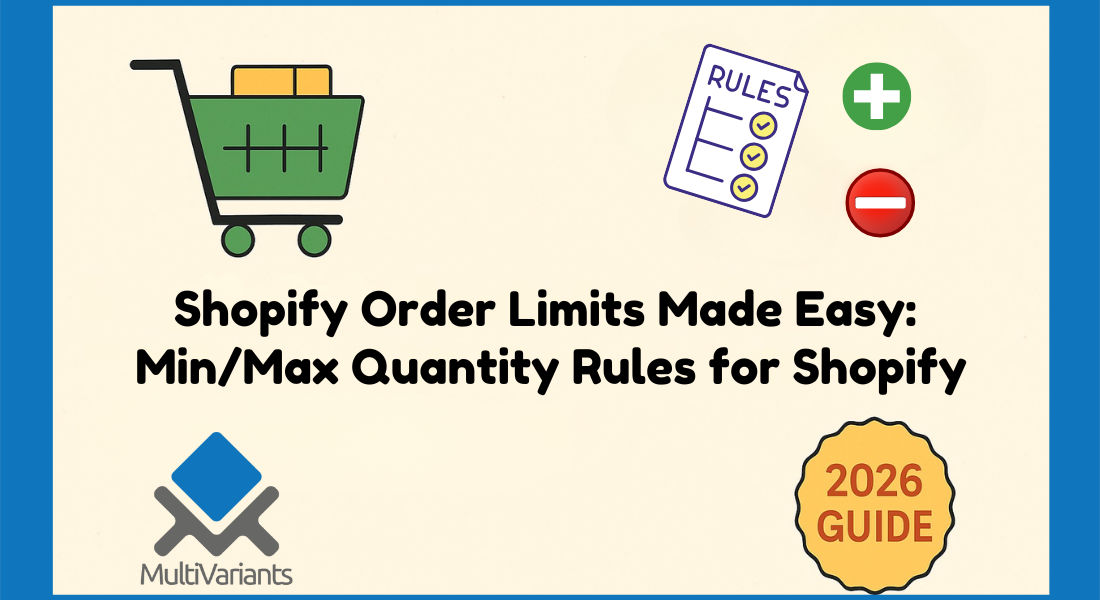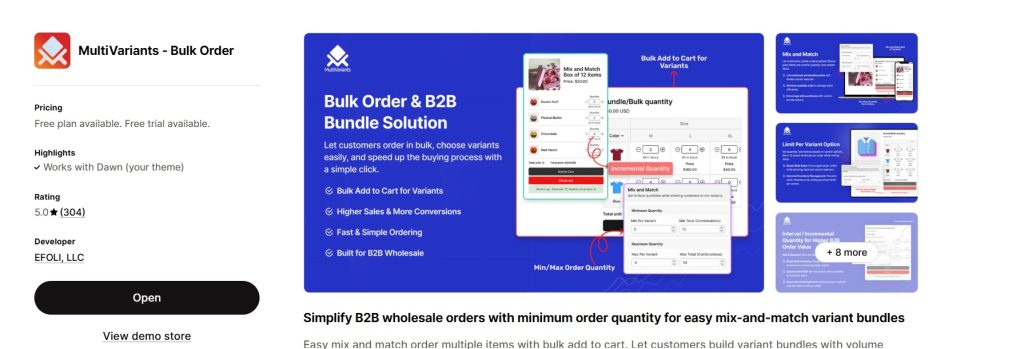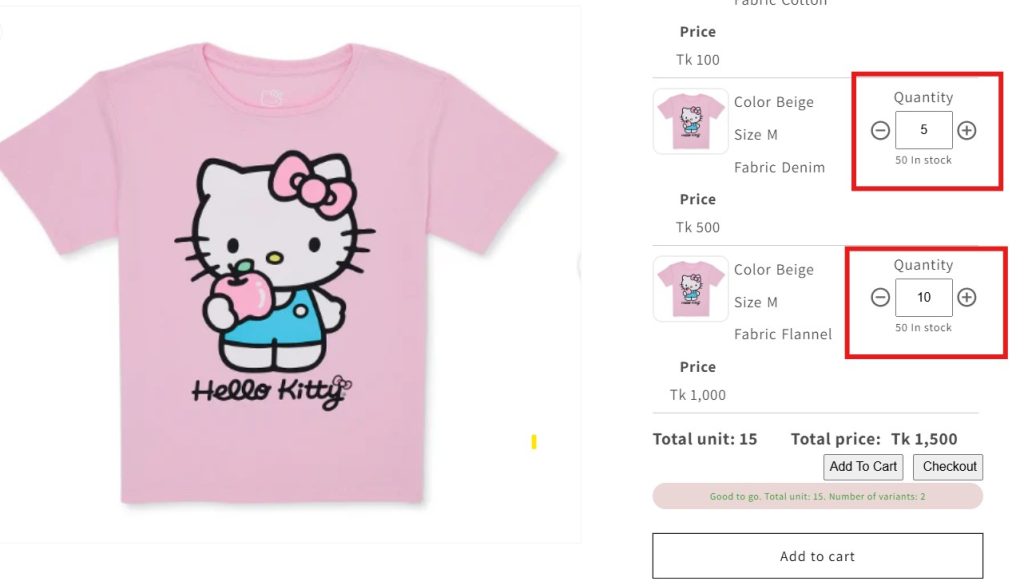
Stanford research shows that Shopify order limits increase basket size when customers meet minimum order rules. This helps stores grow sales and protect profit. Many store owners deal with very small orders that lose money. Then there are single buyers taking too much stock. Both problems hurt margins and make operations messy.
Shopify does not include full quantity control by default, but it is easy to manage. This guide explains how to set Shopify add to cart limits, create minimum and maximum order quantity rules, and use simple tools to make checkout smooth. Without further ado, let us get started.
- Use Shopify order limits to increase sales and protect stock from overselling.
- Minimum and maximum order quantities help control inventory and profits.
- Apps like MultiVariants simplify setting MOQ and max limits without coding.
- Clear communication of limits builds customer trust and prevents cart abandonment.
Table of Contents
What Shopify Order Limits Do
Shopify order limits set how many units a customer can buy in one order. It can apply to a single product, a variant, or an entire cart. These rules keep stock balanced and help avoid unprofitable small orders.
For example, a candle store may ask customers to buy at least three candles but no more than ten. This keeps sales efficient and fair. A sneaker brand may limit one pair per customer during launches to stop resellers. A stationery supplier may allow bulk buyers to order 100 notebooks per design.
You can apply limits storewide or only to some items. Shopify has a simple Add to Cart Limit option under Settings → Checkout → Advanced Preferences that lets you set a maximum per product. It works well for smaller stores and quick promotions.

In the next section, we will explain the difference between minimum and maximum limits. You will realize why these are so important in stock management and ultimately, boosting your sales.
Choosing Minimum, Maximum, or Both
The right rule depends on what you sell and who your customers are.
Shopify minimum order quantity prevents low-value sales that cost more to ship than they earn.
For example, a handmade soap store may set a minimum of four bars to cover packaging costs. A jewelry brand may require two pairs of earrings per order to keep sales profitable.
A maximum order quantity prevents one buyer from taking too much stock.
For example, a skincare store might limit customers to three bottles of its top serum so others can buy.
Using both limits works well for stores with retail and wholesale buyers.
For example, a coffee supplier may set a minimum of 20 bags and a maximum of 200. This keeps supply fair and profitable.
Shopify Plus stores can also set order value limits. For example, orders must be at least $100 but no more than $5,000.
Next, we will learn how order limits on Shopify help stores and why you should apply them to your stores too.
Why Shopify Order Limits Help Stores
Prevent Stockouts
Big sale periods can empty your inventory fast. A maximum order quantity rule keeps products available for more customers.
For example, a T-shirt brand might allow only three shirts per color during Black Friday. A bakery could limit gift box orders to ten per buyer during the holidays.
This helps keep stock longer and customers satisfied.
Protect Margins
Small orders waste time and materials. Setting a minimum keeps each sale worthwhile.
For example, if shipping one candle costs the same as four, a candle shop can require a minimum of four per order. A print shop can set a six-mug minimum to cover setup costs.
Simplify Retail and Wholesale
Limits help manage both groups easily if your store sells to both business and regular buyers.
For example, a stationery shop might allow 5 to 20 notebooks for retail buyers. 50 to 500 for wholesale buyers.
Make Inventory Planning Easier
Knowing the smallest and largest order sizes makes restocking predictable.
For example, a skincare brand with a three-item minimum can plan materials better. A coffee roaster can forecast bean needs more accurately.
Build Trust
Customers appreciate clear rules. For example, a decor store can display “Limit 2 per color” on the product page. A grocery shop can show “Buy 3 packs to get free shipping.” When people know the limits, they shop with confidence.
Now, we will learn how to configure order limits on Shopify without coding. But keep in mind that the setup is for simple product management. We will discuss later how you can easily do that using third-party tools.
How to Set Shopify Order Limits Without Code
Below are three main ways to control quantity:
Shopify Plus Scripts and Checkout Blocks
Shopify Plus stores can use Shopify Functions or Checkout Blocks to create rules.
A B2B electronics supplier might stop checkout if an order is under $500 or above $10,000. The store can show a message asking the buyer to adjust their cart.
These tools work well but have limits. They are only for Plus stores, need developer help, and may stop working after updates.
Manual or Code-Based Options
- Standard Shopify plans have a basic way to set limits.
- Go to Settings → Checkout → Add to Cart Limit.
- Turn on “Set a maximum quantity per item.”
- Enter your number and save.
For example, a flower shop may set a 12-bouquet limit before Valentine’s Day to balance orders.
You can also add simple JavaScript in your theme to alert buyers when they exceed a limit. This method works, but it can break when the theme updates.
Use a Shopify App
The easiest way to handle Shopify quantity limits is with a third-party order limits app called MultiVariants.

You can:
- Set both minimum and maximum order quantity Shopify rules.
- Apply them by product, variant, or across the store.
- Show warnings when customers exceed or fall short.
- Apply rules automatically at checkout.
For example, a T-shirt shop can require “Min 5 per size, Max 10 per variant.” The app automatically restricts customers if they do not follow through.
MultiVariants Min/Max Order Quantity Setting

Product page after applying MultiVariants

In the next section, we will be sharing some real-world examples where you can apply quantity rules. From wholesale to retail stores, everyone benefits from Shopify quantity limits.
Examples for Different Store Types
Retail Stores During Promotions
A max quantity Shopify rule helps avoid bulk hoarding during sales.
For example, a skincare store may allow only two serums per customer during discounts to keep the deal fair.
Wholesale and B2B Sellers
Bulk sellers can control flow with both minimum and maximum rules.
For example, a packaging supplier may set 100 boxes minimum and 500 maximum per order. This keeps production stable and fair.
Limited or Seasonal Products
Stores selling rare items can prevent resellers from buying too many.
For example, a jewelry brand with 200 limited necklaces can limit one per customer. A sneaker shop can allow one pair per size per buyer.
Subscription Stores
Subscription stores can control recurring orders for predictability.
For example, a coffee plan can require two bags per flavor and cap it at eight per month. This helps plan packaging and stock.
Make the Rules Clear
Communicating clearly with your customers is very important. Clear communication keeps shoppers informed and reduces cart abandonment. Below are some tips to make sure you sell smoothly.
- Tell customers about limits before checkout.
- Add notes near the Add to Cart button.
- Use short messages like “Minimum 4 per order” or “Limit 5 per style.”
- Show a pop-up if customers go over the limit.
- Offer rewards like “Buy 5 and get 10% off.”
For example, a skincare store might show “Buy 3 and get free shipping.” A furniture shop might display “Limit 2 sofas per color.”
Variant Limits to Keep in Mind
Shopify variant limits are not the same as order quantity limits. Standard plans allow 100 variants per product. Shopify Plus allows 2,000. The total variant limit per store is 50,000 before Shopify pauses new imports for a day.
For example, a shoe store with 10 colors and 10 sizes already reaches 100 variants.
Adding more options becomes difficult and slows down product management. This is why using quantity limits often works better than creating extra variants. It keeps your product pages clean, reduces loading issues, and makes inventory easier to control.
Track and Adjust Performance
After setting Shopify order limits, measure the results. Watch your average order value, cart abandonment, and inventory turnover.
For example, a candle shop raised its AOV by 20 percent after adding a 4-item minimum. A coffee brand saved 15 percent on packing time by standardizing order sizes.
Review results often and adjust if needed. Use Shopify analytics to track results and figure out what you are doing right and what you are doing wrong. The next section lists some common mistakes that you need to be aware of.
Common Mistakes
- Setting limits too high or too low. For example, a $300 product with a 10-unit minimum may lose customers.
- Forgetting to apply limits to all variants.
- Showing alerts only at checkout.
- Leaving “Continue selling when out of stock” on. It overrides your limits and can cause overselling.
Use a bulk order app to manage your product variants easily. No manual errors, no messy inventory, and no confusion. It will be quick and efficient. You will get time to focus on other tasks for your business.
Conclusion
Setting Shopify order limits helps control profits, stock, and fairness. These rules make orders predictable and operations efficient. Shopify data shows that using both minimum and maximum limits improves sales and customer experience. The platform’s built-in tools work for basic setups. Using an order limit app gives full control.
We hope this article was helpful and informative. Follow all the tips and see your sales soar. Share this guide with other Shopify merchants. Check out our other blogs for more tips like these. See you next time!
FAQs
Can you limit orders on Shopify?
Yes. Shopify does not include full order limits by default, but you can enforce limits with apps like MultiVariants or with custom code.
What is the 50,000 variant limit on Shopify?
Shopify pauses new variant imports for the day once your store reaches 50,000 total variants, but existing variants continue to work normally.
Does Shopify have a limit?
Yes. Shopify has limits for variants, API calls, page sections, and some file sizes to keep stores running smoothly.
What are the limitations of Shopify?
Common limitations include variant limits, restricted checkout customization, and fewer bulk management features without apps.
What are the limitations of Shopify Plus?
Shopify Plus still has variant limits, checkout extensibility restrictions, and requires apps for many advanced features.
What is the biggest problem with Shopify?
Most merchants mention variant limits and the need for multiple apps to add advanced functions.
How to set an order limit on Shopify?
You can add order limits through theme code, Shopify Scripts (Plus), or an app like MultiVariants.
Can I set Shopify add to cart limits per product?
Yes. Go to Settings → Checkout → Add to Cart Limit and enter your number.
Do limits apply to variants or whole products?
Each variant is separate. For example, 30 per color or size. By using an app, you can do both.
What is the Shopify variant limit per product?
100 for standard plans, 2,000 for Plus.
What is the total variant creation limit per store?
50,000 variants before a short delay.
What happens if we continue selling when out of stock?
It overrides your limits and may cause overselling. Turn it off.
